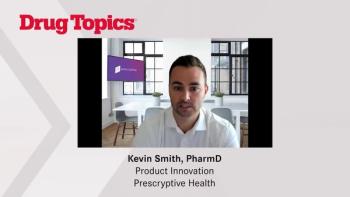
Lagging until now, electronic prescribing set to expand
New Medicare law to boost electronic prescribing
TECHNOLOGY
Lagging until now, electronic prescribing set to expand
Electronic prescribing is coming. Three-quarters of U.S. pharmacies can already accept electronic scripts, and 20% of physicians are prescribing electronically. Most other pharmacies and physicians will be on board by Jan. 1, 2006.
That's the state of the industry, according to Simon Cohn, M.D., member of the National Committee on Vital and Health Statistics. NCVHS is the chief health information policy adviser to the Department of Health & Human Services.
"The Medicare Modernization Act of 2003 requires national standards for e-prescribing by 2009," Cohn told a National Council for Prescription Drug Programs (NCPDP) educational forum in San Francisco. "The Centers for Medicare & Medicaid Services has already announced that it expects standards to be in place when Medicare Part D takes effect in 2006. There are likely to be regulations for e-prescribing sooner rather than later." Initial standards will be released late this year, he added.
Standards can't come too soon for J. Marc Overhage, M.D., senior investigator at the Regenstrief Institute in Indianapolis. He helped create the Indiana Network for Patient Care, linking physicians, pharmacies, hospitals, and laboratories across Indianapolis with electronic medical records and e-prescribing. "Everything we have done is based on standards," he said. "It's not rocket science. You just need to follow principles to ensure that everyone understands the same things from the same words."
Even electronic prescribing itself needs a standard. The term covers several models, explained forum moderator Ross Martin, M.D., senior manager of Pfizer's strategic technology group.
How e-prescribing works
E-prescribing starts with devices that print out a prescription the patient takes to the pharmacy. More complex systems fax the script. Complete e-prescribing gives the prescriber medical history, formulary, prior authorization requirements, treatment guidelines, cost comparisons, and utilization review. The completed Rx moves electronically to the patient's chosen pharmacy.
"The goal is all electronic, all the time," Martin said. "Anytime you reduce the process to paper, it begins to break down." None of the key players in the systempatient, prescriber, pharmacist, or payerhas adequate information, he explained. But all make decisions as though they did.
According to the National Association of Chain Drug Stores, up to 40% of prescriptions need extra work before dispensing. Pharmacies make 150 million phone calls to physician offices yearly to clarify handwriting, dosing, eligibility, and other issues.
"Every day, the equivalent of a passenger jet is crashed with no survivors because of inadequacies in the prescribing system," said Helga Rippen, M.D., deputy senior adviser of the National Health Information Infrastructure for HHS. "We need to find ways to minimize the cost."
Cohn said NCVHS and HHS have already concluded that uniform standards are needed to ensure that all providers will be able to communicate with all pharmacies and all payers.
What standards are needed
Key standards include:
Identifying unique prescribers independent of setting
Creating unique patient identifiers without violating privacy requirements
Creating, maintaining, and transmitting medical history information
Transmitting prior authorization and formulary requirements to prescribers before the script is written
Creating a uniform dictionary of drug names, formulations, and dosing instructions
Federal preemption of state pharmacy requirements, at least for Medicare scripts
"We hope the vendor community will adopt standards before they are mandated by the government," Rippen said. "We don't want to regulate if we don't have to. But government can't favor one vendor over another, so we are not likely to implement any proprietary standards. We are looking forward to open standards."
Open standards are basic for Janet Marchibroda, CEO of eHealth Initiative. The Washington, D.C.-based interest group is pushing for an interconnected electronic health information system. "We're way behind every other industry group in information technology [IT]," she said. "Health care is unwired."
According to Marchibroda, health care invests 2.2% of revenues in IT. That compares with 6.5% for consumer services, 8.1% for insurance, and 11.1% for financial services. Only one-third of hospitals have computerized physician order entry (CPOE) systems, and just 4.9% require their use. National adoption of ambulatory CPOE would prevent two million adverse drug events annually, she said, including 190,000 adverse drug event-related hospital admissions and 130,000 life-threatening events. Annual healthcare savings could hit $44 billion.
"The conversation about standards is tied to payer innovations, like not getting a contract without adhering to standards," Marchibroda said. "The focus has shifted from whether we should do e-prescribing to how we will do it."
The answer, so far, is inconsistently.
Doug Bell, M.D., surveyed commercial e-prescribing systems in 2002 for RAND Corp. Bell is assistant professor of medicine at the David Geffen School of Medicine at the University of California Los Angeles. Of 58 commercial e-prescribing products, only 29 met criteria emphasizing patient interests in safety, health outcomes, and cost management. "Commercial e-prescribing systems are not consistent in implementing features and functions," he said. "We need standards to establish minimum functionality."
Walgreens has been filling e-scripts for a decade, said Mike Simko, manager of pharmacy systems for Walgreen Co. Most arrive as faxes, but he wants more purely electronic scripts to reduce manual entries into pharmacy computer systems. "Every keystroke in the pharmacy introduces a chance for error," he explained. "Pharmacy and physician management systems have to make it easier to generate and process an e-script than a paper script. But there are tremendous hardware and software costs in implementing e-prescribing in physician offices. Many physicians are reluctant to commit."
Patient demand can help move reluctant physicians. Patient groups like e-prescribing because it offers the promise of more evidence-based treatment. "The problem is making sure that drug treatment is done in accordance with accepted guidelines," said Andrew Sperling, director of legislative advocacy for the National Alliance for the Mentally Ill. "Physician compliance with guidelines is a key issue. We have a real stake in making sure e-prescribing delivers on the promise" of providing evidence-based treatment guidelines.
Drugmakers also like e-prescribing. Michael Weinberger, executive director of Johnson & Johnson Health Care Systems' prescribing alliance, said that e-prescribing can't happen fast enough. "You get better compliance, fewer medication errors, more efficient treatment, and lower cost," he explained. "But the return has been clearer to pharmacy and to payers than to physicians. We need to make the value and the message clearer to physicians."
The industry is trying. RxHub, formed by Medco, AdvancePCS, and Express Scripts, is focusing on providing preprescribing information, including prior Rx history, said medical affairs VP Bob Elson, M.D. SureScripts, created by NACDS and the National Community Pharmacists Association, he added, is easing electronic data exchange between physician and pharmacy.
New group formed
Nine healthcare IT groups have formed their own alliance called Café Rx (
"We have the capability to eliminate paper from the prescribing process," said SureScripts COO Rick Ratliff. "Payers are coming to the table; health systems are coming to the table. It's time to get on board."
Fred Gbhart
Fred Gebhart. Lagging until now, electronic prescribing set to expand.
Drug Topics
Sep. 13, 2004;148:53.
Newsletter
Pharmacy practice is always changing. Stay ahead of the curve with the Drug Topics newsletter and get the latest drug information, industry trends, and patient care tips.




